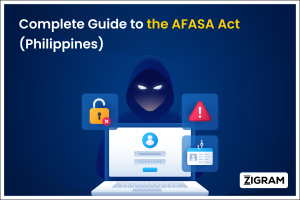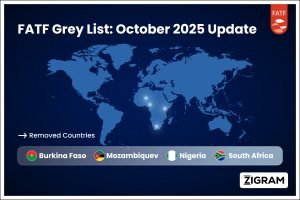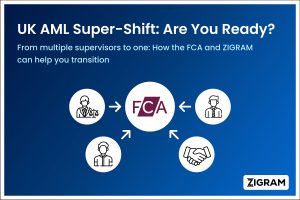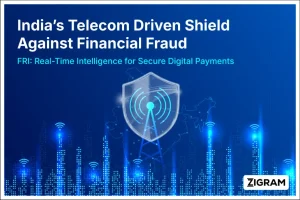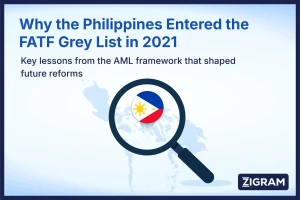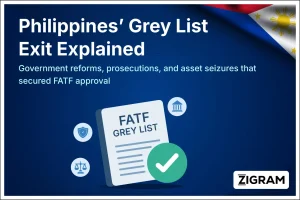Table of Contents
In the late 1990s and early 2000s, the Philippines lacked specific legislation against money laundering. No suspicious transaction reporting system existed, and bank secrecy remained largely unchallenged and creating a permissive environment for illicit financial flows. In June 2000, the Financial Action Task Force (FATF) flagged the Philippines as a non-cooperative country, risking financial isolation, higher transaction costs, and limited access to global banking networks.
To address this, the Bangko Sentral ng Pilipinas (BSP), under Governor Rafael Buenaventura, campaigned for legislation criminalizing money laundering and establishing institutional mechanisms aligned with international standards. After nearly a year of legislative debate, Congress enacted the Anti-Money Laundering Act (RA 9160) in September 2001, and created the Anti-Money Laundering Council (AMLC) to serve as the Philippines’ financial intelligence unit. [1] [6]
Today, AMLA mandates robust compliance measures including customer due diligence, suspicious transaction reporting, and transaction monitoring—across both traditional financial institutions and designated non-financial businesses. This guide explores AMLA’s evolution, enforcement mechanisms, obligations, and real-world impacts—offering a complete roadmap through the Philippines’ anti-money laundering landscape.

The Philippines AML Act 2001 And Framework
Origins and Purpose of the Philippines AML Act (2001)
Republic Act No. 9160 (1), popularly known as the Anti-Money Laundering Act of 2001, was enacted on September 29, 2001. Its principal aim was to:
- Define money laundering as a criminal offense.
- Protect the integrity and confidentiality of bank accounts.
- Prevent the Philippines from being used as a money laundering site.
- Foster cooperation in transnational investigations and prosecutions.
Institutional Framework: The Anti-Money Laundering Council In Philippines
To execute AMLA’s mandates, the law established the Anti-Money Laundering Council (AMLC), composed of:
- Governor of the Bangko Sentral ng Pilipinas (BSP) — Chairman
- Commissioner of the Insurance Commission (IC) — Member
- Chairperson of the Securities and Exchange Commission (SEC) — Member
Core Definitions and Compliance Obligations under the AMLA
Money Laundering – Definition under Philippine Law
AMLA defines money laundering as transactions involving:
- Conversion, transfer, or disposition of proceeds of unlawful activity to disguise their illegitimate origin.
- Concealment of origin, location, or ownership.
- Acquisition, possession, or use of said proceeds.
Predicate Crimes and Unlawful Activities
These are predicate crimes defined across various categories, such as:
- Kidnapping for ransom, drug trafficking, terrorism, smuggling, fraud, corruption, trafficking in persons, and tax evasion.
Covered Institutions and Reporting Entities
Initially, covered institutions included entities supervised by BSP, IC, and SEC—such as banks, quasi-banks, insurance firms, securities firms, money changers, and others.
Transaction Thresholds
- Originally, these meant transactions exceeding PHP 4 million within five banking days, unless justified.
Reporting Obligations
- All covered transactions must be reported to the AMLC within five working days, extendable up to ten by supervising authorities.
- Suspicious transactions—regardless of amount—must also be reported.
AML Amendments And Full Scope of Law
Major Amendments of AML Act over the years
Republic Act No. 9194 (2003)
Expanded the definitions of covered institutions, reinforced reporting structures, and enhanced AMLC’s authority to identify parties in suspicious transactions.
Republic Act No. 10167/10168 (2012)
Introduced provisions targeting terrorist financing, allowing the AMLC to conduct bank inquiries and issue freeze orders without court orders—albeit temporarily.
Republic Act No. 10365 (2013)
Further strengthened AMLA by expanding covered persons (real estate, precious metals, etc.) and reinforcing the reporting of foreign exchange, real estate, jewelry, and precious metal suspicious transactions.
Republic Act No. 10927 (2017)
For the first time, criminalized money laundering in the casino sector, including online and ship-based casinos. Transactions exceeding PHP 5 million trigger reporting obligations.
2018 IRR and 2021 Amendments
Implemented detailed rules (IRR) for compliance, and recent updates in 2021 further added two categories as covered persons (real estate developers and brokers; offshore gaming operators), raised transaction thresholds, and incorporated new predicate crimes (e.g., NSC-STMCom violations and high-value tax evasion).
Additional Amendments (e.g., RA 11521)
Broadened scope by enabling FATF-recommended enhancements like real-time monitoring and more granular reporting for covered persons.
Scope: Who Must Comply with the AML Act and What Transactions Are Covered
Covered Persons
Under the amended AMLA, covered persons include:
- Banks, non-banks, insurance companies, securities dealers (under BSP, IC, SEC).
- DNFBPs like casinos (including internet/ship-based), real estate developers and brokers, offshore gaming operators, dealers in precious metals/stones, lawyers, accountants (with IFR limitations).
Transaction Thresholds
- PHP 500,000 per day for general covered transactions.
- PHP 5 million per single casino cash transaction.
- PHP 7.5 million per real estate transaction in cash.
Customer Due Diligence, Record-Keeping and Compliance Controls
Customer Due Diligence and Record-Keeping
Regulated institutions must:
- Verify the identity of clients using official documents.
- For corporate clients, ascertain legal existence and authorized parties, anonymous or fictitious accounts are prohibited.
- Retain transaction records for at least five years, including those of closed accounts. Foster internal AML/CFT policies, appoint a compliance officer, provide training, and operate a risk-based monitoring approach.
AML Freeze Orders, Investigations & Civil Forfeiture
Freeze Orders
When probable cause exists that assets are linked to unlawful or terrorist-related activities, the AMLC may apply ex parte for freeze orders, effective immediately for 15 days, extendable by the Court of Appeals.
Investigations & Enforcement
AMLC can initiate investigations, request identifying information, institute civil forfeiture proceedings, and file complaints with the Department of Justice or Ombudsman. It also may request assistance from other government agencies.
Enforcement, Penalties and High-Profile Cases under AML Laws
Penalties for AML Non-Compliance and Offenses
Persons convicted of money laundering face imprisonment (6 months to 14 years) and fines (PHP 100,000 up to twice the value of laundered property). Under TFPSA, terrorism financing carries penalties from reclusion temporal up to reclusion perpetua, and fines from PHP 500,000 to PHP 1 million.
Administrative Sanctions
Fines, warnings, reprimands or license revocation may be imposed, tailored to the seriousness and size of offending institutions.
High-Profile Cases
- RCBC was fined PHP 1 billion for its role in laundering USD 81 million stolen from Bangladesh Bank via casinos.
- A criminal case involving Major General Carlos F. Garcia resulted in 168 months imprisonment and fines of PHP 407.8 million for bribery and money laundering.
International Cooperation, FATF Compliance and Strengthening Financial System Integrity
International Cooperation & AML Compliance with Global Standards
The AMLC serves as the Financial Intelligence Unit (FIU), overseeing AML/CTF implementation and coordinating with FATF, APG, and other international bodies.
The Philippines participates in mutual legal assistance and follows global AML standards. OCWs' remittances, for example, are affected by AML compliance status; efforts are ongoing to remove the Philippines from FATF’s grey list to avoid restrictions.
Strengthening Financial System Integrity in the Philippines AML Act
The Philippines AMLA—first enacted in 2001 and progressively strengthened through multiple amendments—reflects the country’s commitment to maintaining a clean, transparent financial system aligned with global standards.
Key takeaways:
- Comprehensive Coverage: From banks to casinos, and real estate to offshore gaming.
- Robust Reporting System: Both covered (threshold-based) and suspicious (regardless of amount) transactions must be duly reported.
- Strong Institutional Machinery: AMLC empowered with investigative, freezing, and enforcement tools.
- Significant Penalties: Both administrative and judicial sanctions for non-compliance.
- Global Synchronization: Continuous alignment with FATF, APG, and international partners.
Sources
1. Republic Act No. 9160 – Anti-Money Laundering Act of 2001 (AMLA) (Anti-Money Laundering Council)
2. Republic Act No. 11521 (2021 Amendment to AMLA) (Lawphil)
3. Harold Respicio – “Money Laundering under the Anti-Money Laundering Act (as amended)” (Nov 8, 2024) (RESPICIO & CO)
4. The Politics of the Anti-Money Laundering Act of the Philippines (Assessment of RA 9160 & RA 9194) – Asian Social Science (2010) (ResearchGate, CCSE)
5. Supreme Court Ruling: Freeze Orders under AMLA May Include Related Accounts (SC decision, May 29, 2025) (Supreme Court of the Philippines)
6. Anti-Money Laundering Council (AMLC) — Wikipedia overview of mandate, composition, and functions (Wikipedia)
- #GENIUSAct
- #Stablecoins
- #AML
- #FinancialCrime
- #Compliance
- #CryptoRegulation
- #FinCEN
- #SanctionsCompliance
- #RegTech
- #AntiMoneyLaundering
- #DigitalAssets
- #FinancialSecurity

